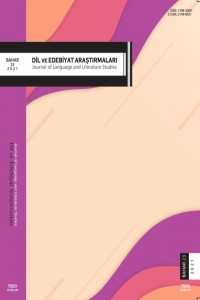The Technical Analysis Of The Short Stories From The Work I Saw The Palm (Raaytu an-Nakhl) Of Radwa Ashour
Abstract
Egyptian writer and academician Radwa Ashour, who was born in 1946 in Cairo and died in 2014 in Cairo, penned several novels, stories, translations and academic works. In this study the technical analysis of short stories titled He Wants to be Reassured, Safsafa and General, The Man Sitting in the Park is Waiting, In the Cold Room, Under the Moon Light, A Day Unlike the Other Days, Abroad, I Saw the Date Palm in Ashour’s work I Saw the Date Palm (Ra’eytu en-Nahl), which includes 8 short stories and 30 very short stories and which was first published in 1989, was conducted in terms of title, plot, narrator and point of view, characters, time, place, language and style, and narrative techniques.
Ashour, in these stories narrates the slices of the lives of people from different classes of the Egyptian society by giving particular importance to characters’ states of mind, feelings and thoughts rather than the incidents. In her stories, the writer presents the incidents, most of which take place in short periods of time, sometimes from the first-person singular viewpoint and sometimes from the third-person singular viewpoint in a fluent language and a plain style. It is seen that Ashour used autobiographic, depiction, dialog, interior monolog, stream of consciousness, montage, letter, leitmotiv and cutback techniques in these short stories.
References
- Aktaş, Şerif (1991), Roman Sanatı ve Roman İncelemesine Giriş, Ankara: Akçağ Yay, 2. bs.
- Bildik, Yusuf (2019), Hasib Keyyali'nin Hikâyelerinde Sosyal Problemler, Konya: Billur Yay.
- Çakır, Hasan (2002), Öykü Sanatı, Konya: Çizgi Yay, 2. bs.
- Çetin, Nurullah (2006), Roman Çözümleme Yöntemi, Ankara: Kalemdar Yay, 4. bs.
- Çetişli, İsmail (2009), Metin Tahlillerine Giriş 2/Hikâye-Roman-Tiyatro, Ankara: Akçağ Yay, 2. bs.
- Doğru, İhsan (2018), “Endülüslü Müslümanlara Uygulanan Zulmün 20. yy. Romanına Yansıması: Radva ʻÂşûr’un ‘Granada Üçlemesi’ Örneği”, Ed. Deniz ABİK, II. Uluslararası Multidisipliner Çalışmalar Kongresi Filoloji ve Edebiyat, 4-5 Mayıs 2018, Ankara: Akademi Yay, s. 158-182.
- Drumsta, Emily (13.12.2016), “Two Stories by Radwa Ashour. Jadaliyya”, https://www.jadaliyya.com/Details/33827/Two-Stories-by-Radwa-Ashour. (Erişim tarihi: 07.11.2020). Erden, Aysu (1998), Kısa Öykü ve Dilbilimsel Eleştiri, Ankara: Gündoğan Yay.
- Halil, Ahmed (2019), Velid İhlasi’de Kısa Hikâye Sanatı, Konya: Eğitim Yay.
- Hartman, Michelle (2016), “The Journey by Raswa Ashour”, Comparative American Studies an International Journal 13 (4), 1-11. https://doi.org/10.1080/14775700.2015.1178943
- Moran, Berna (1988), Edebiyat Kuramları ve Eleştiri, İstanbul: Cem Yay, 6. bs.
- Özdemir, M. Büşra (2017), Radva Aşur ve Sülasiyyetü Gırnata Adlı Eserinde Göç Teması, İstanbul: Marmara Üniversitesi Sosyal Bilimler Enstitüsü (yayınlanmamış yüksek lisans tezi).
- Tekin, Mehmet (2017), Roman Sanatı, İstanbul: Ötüken Yay, 15. bs.
- Tepebaşlı, Fatih (2012), Roman İncelemesine Giriş, Konya: Çizgi Yay.
- Yazıcı, Hüseyin (1998), “Hikâye”. DİA, XVII, İstanbul: Türkiye Diyanet Vakfı Yay, s. 479-485.
Abstract
1946’da Kahire’de doğan ve 2014 yılında Kahire’de vefat eden Mısırlı yazar ve akademisyen Radvâ Âşûr, çok sayıda roman, hikâye, çeviri ve akademik eser kaleme almıştır. Bu çalışmada Âşûr’un 8 kısa hikâye ile 30 çok kısa hikâyenin yer aldığı ve ilk kez 1989 yılında basılan Hurma Ağacını Gördüm (Ra’eytu en-Nahl) adlı eserinde yer alan Gönlü Rahat Olmak İstiyor, Safsâfa ve General, Parkta Oturan Adam Bekliyor, Soğuk Odada, Ay Işığında, Diğer Günler Gibi Olmayan Bir Gün, Gurbet ve Hurma Ağacını Gördüm adlı kısa hikâyelerin başlık, olay örgüsü, anlatıcı ve bakış açısı, şahıs kadrosu, zaman, mekan, dil ve üslup ile anlatım teknikleri unsurları açısından teknik incelemesi yapılmıştır. Âşûr, bu hikâyelerde Mısır toplumun değişik tabakalara mensup kişilerin hayatlarından kesitleri olaylardan ziyade kişilerin ruhsal durumlarını, duygu ve düşüncelerini ön planda tutarak aktarmaktadır. Yazar hikâyelerinde çoğunluğu kısa zaman dilimlerinde geçen olayları bazen birinci tekil şahıs bazen de üçüncü tekil şahıs bakış açılarıyla fasih bir dille ve yalın bir üslupla okuyucuya sunmaktadır. Âşûr’un hikâyelerinde otobiyografik, tasvir, diyalog, iç monolog, bilinç akımı, montaj, mektup, laytmotif (ana motif) ve geriye dönüş tekniklerini kullandığı görülmektedir.
References
- Aktaş, Şerif (1991), Roman Sanatı ve Roman İncelemesine Giriş, Ankara: Akçağ Yay, 2. bs.
- Bildik, Yusuf (2019), Hasib Keyyali'nin Hikâyelerinde Sosyal Problemler, Konya: Billur Yay.
- Çakır, Hasan (2002), Öykü Sanatı, Konya: Çizgi Yay, 2. bs.
- Çetin, Nurullah (2006), Roman Çözümleme Yöntemi, Ankara: Kalemdar Yay, 4. bs.
- Çetişli, İsmail (2009), Metin Tahlillerine Giriş 2/Hikâye-Roman-Tiyatro, Ankara: Akçağ Yay, 2. bs.
- Doğru, İhsan (2018), “Endülüslü Müslümanlara Uygulanan Zulmün 20. yy. Romanına Yansıması: Radva ʻÂşûr’un ‘Granada Üçlemesi’ Örneği”, Ed. Deniz ABİK, II. Uluslararası Multidisipliner Çalışmalar Kongresi Filoloji ve Edebiyat, 4-5 Mayıs 2018, Ankara: Akademi Yay, s. 158-182.
- Drumsta, Emily (13.12.2016), “Two Stories by Radwa Ashour. Jadaliyya”, https://www.jadaliyya.com/Details/33827/Two-Stories-by-Radwa-Ashour. (Erişim tarihi: 07.11.2020). Erden, Aysu (1998), Kısa Öykü ve Dilbilimsel Eleştiri, Ankara: Gündoğan Yay.
- Halil, Ahmed (2019), Velid İhlasi’de Kısa Hikâye Sanatı, Konya: Eğitim Yay.
- Hartman, Michelle (2016), “The Journey by Raswa Ashour”, Comparative American Studies an International Journal 13 (4), 1-11. https://doi.org/10.1080/14775700.2015.1178943
- Moran, Berna (1988), Edebiyat Kuramları ve Eleştiri, İstanbul: Cem Yay, 6. bs.
- Özdemir, M. Büşra (2017), Radva Aşur ve Sülasiyyetü Gırnata Adlı Eserinde Göç Teması, İstanbul: Marmara Üniversitesi Sosyal Bilimler Enstitüsü (yayınlanmamış yüksek lisans tezi).
- Tekin, Mehmet (2017), Roman Sanatı, İstanbul: Ötüken Yay, 15. bs.
- Tepebaşlı, Fatih (2012), Roman İncelemesine Giriş, Konya: Çizgi Yay.
- Yazıcı, Hüseyin (1998), “Hikâye”. DİA, XVII, İstanbul: Türkiye Diyanet Vakfı Yay, s. 479-485.
Details
| Primary Language | Turkish |
|---|---|
| Journal Section | ARTİCLES |
| Authors | |
| Publication Date | March 20, 2021 |
| Acceptance Date | March 7, 2021 |
| Published in Issue | Year 2021 Issue: 23 |
Journal of Language and Literature Studies is licensed under the Creative Commons Attribution-Non-Commercial-NoDerivatives 4.0 International Licence (CC BY-NC-ND 4.0).


